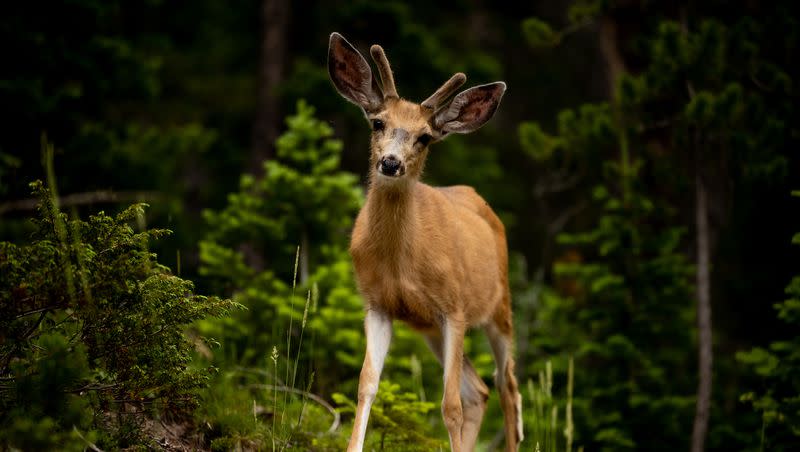As Utah’s hunt gets underway, here’s what tracking tells us about the estimated 350K deer that live among us

Most deer in Utah don’t wander far from where they are born, typically migrating 10 to 15 miles annually.
They tend to travel the pathways taught to them by their mothers and taught to those does by their mothers, which has been verified by data collected from GPS units attached to collars by Utah Division of Wildlife Resources biologists.
“It’s really just kind of like blown the lid off of what we know about deer and their movements,” said Blair Stringham, the division’s migration initiative coordinator in an interview on the eve of Utah’s general deer hunt, which begins Saturday.
In 2017, the Utah Division of Wildlife Resources launched a statewide initiative to identify, preserve and enhance movement corridors for land and aquatic wildlife species, which has provided invaluable data to wildlife managers.
GPS technology enables the division to more readily gather information about deer’s migration patterns, their health, longevity and where and how they die.
Stringham hesitates to make sweeping statements about the well-being of deer because much depends on where they were born. That’s why the division tracks them in each of its designated hunting units.
For example, last winter’s heavy snowfall resulted in lower survival rates of adult doe deer and fawns in Cache, Weber, Summit and Morgan counties. That means fewer buck deer — especially yearling bucks — are available for hunters in those areas this fall, according to a division press release.
“We collar generally around 1,000 deer each year. We collar them pretty much all across the state. We’ve got 26 hunt units. So they’re kind of county sized areas that encompass essentially populations of deers’ winter and summer range,” Stringham said.
How far do they go?
Much varies deer to deer and where they happen to live, Stringham said.
“If you’re a deer that lives kind of west of I-15 in more of a desert habitat in Utah, those deer aren’t really moving around as much. Their migrations are generally shorter and a lot of times they just kind of wander around the desert within a smaller home range,” he said.
It’s a different story for deer that live at higher elevations along the Wasatch Front or in the Uinta Mountains.
“A lot of that is because they spend the summer up at 10,000 or 11,000 feet and then they have to move down because of snow and food availability,” he said.
It is not uncommon for those deer to migrate 30 to 40 miles. “We have deer moving a long ways to go between winter and summer range,” Stringham said.
Migration patterns are learned behavior so generations of deer tend to travel the same paths.
“So they’ll learn it from their mother or they’ll pass it on to their offspring. And so a lot of these migration corridors have been there for a long, long time,” which can be problematic if a new road is developed in an area traveled by generations of deer, he said.
One well-traveled doe
Migration data revealed the habits of one deer wildlife biologists considered well beyond the norm, even among deer that live high up in Utah’s mountains.
“The longest one we’ve had was a deer that was on the north slope of the Uintas, so kind of between Evanston and the top of the Uintas along the Mirror Lake Highway. It went straight east along the whole north side of the Unitas and then south toward Vernal. It wintered in the Vernal area. It was a migration over 70 miles. That’s definitely kind of the extreme,” Stringham said.
Top causes of mortality
Utah’s heavy snowfall clearly took its toll on deer populations in some parts of the state but other factors contribute to their deaths.
Motor vehicle-deer crashes claim the lives of thousands of deer each year. A 2012 study by the Utah Division of Wildlife Resources found there were 10,000 such collisions that year, although the division built fences and wildlife bridges along migration routes to help lower those numbers.
About 20,000 deer are killed each year during the annual deer hunts, he said.
Otherwise, accidents, disease and predators kill a significant number of deer.
“We see a lot of does, when they’re giving birth, will die. Weird stuff happens, like breaking their legs or falling in holes. And then, predators. We’ve seen our mountain lion population being pretty healthy lately and we’re finding they’re taking quite a few deer. Coyotes and bears will take some as well,” Stringham said.
No single factor that cuts into the deer population “outside better habitat. There are just a variety of things that can kill a deer at any point. It’s just a tough world out there,” he said.
Related
Average lifespan
The average lifespan of a deer in Utah is four to five years but much depends on their habitat.
“The first two years is really, really hard for deer,” particularly young fawns born to moms that enter winter in compromised condition.
“That next year life can be pretty difficult as well because that’s when their moms kind of kick them off and have their new fawns. If they can get to be kind of that 2 year old or older, like life’s generally a lot better for them. We’ve seen some of our collared does get into their teens, bucks usually don’t live as long.”
Again, location matters.
“Usually the ones that have to migrate less tend to live a little bit longer,” he said.

